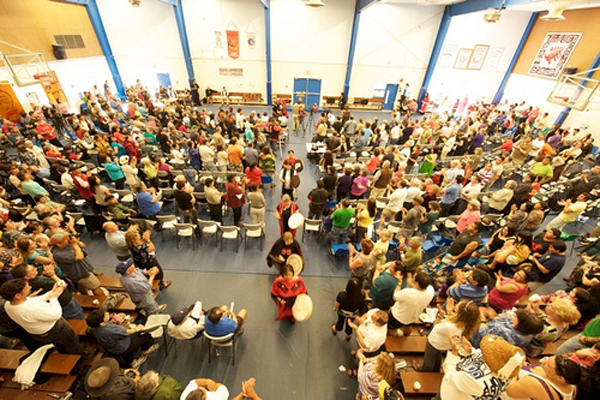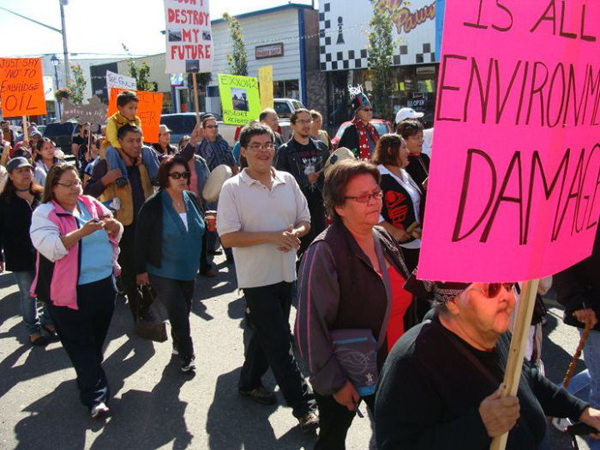More than five years ago, in a patch of coastal rainforest not far from the mouth of the Kitimat River, what was supposed to have been a quiet land survey turned into a public relations nightmare.
The purpose of the survey was to scout locations for an upland terminal and tank farm site, part of the infrastructure needed to stretch a 1,172 kilometre steel pipeline from Alberta's booming oil sands to B.C.'s ragged north coast.
The Calgary-based pipeline company Enbridge had contracted the job to an international engineering and consulting firm named AMEC, which, in 2006, sent survey members into old-growth forest dense with Sitka spruce and Western red cedar.
Covered by thick moss and ferns, this area, about 700 kilometres north of Vancouver, is literally a living museum of First Nations history.
Scattered throughout the forest are deeply notched tree trunks where Haisla peoples once stripped bark for their baskets, or took planks to build their homes.
Carbon-date these culturally modified trees, Haisla leaders say, and you can establish native land claims dating back hundreds, even thousands, of years.
Sometime during their expedition, AMEC workers chopped down 14 of these trees, irreplaceable artefacts in a culture largely built on oral histories. (A company spokesperson declined to explain why.)
Worse yet was that Haisla leaders didn't know their territory was being surveyed at all until Enbridge got in contact to make amends.
"We compared it to a thief breaking into your house and destroying one of your prized possessions, and then calling you later to apologize for it," Haisla councillor Russell Ross Jr. told The Tyee.
What followed over the next five years was a blueprint for how not to engage with native communities, an incident that to this day remains unresolved.
The picture that emerges, and from several milestones like it, is a decade-long First Nations consultation process fraught with errors and missteps.
And with historic public hearings on the $5.5 billion Northern Gateway pipeline just begun last week on Haisla territory, some observers think Enbridge may be in a much more precarious legal position than most people are aware.
Making a tough sell tougher
Northern Gateway was always going to be a tough sell to B.C.'s First Nations, no matter how good the relationship between Enbridge and their communities.
The proposed pipeline, after all, would cross hundreds of salmon-spawning streams and rivers across the northern Interior.
These are spiritual and economic lifelines for such cultures as the Dakelh (more commonly known as the Carrier peoples) whose name translates to "people who go around by boat."
Few First Nations west of the Rocky Mountains have signed Crown treaties either, leaving the rights and title to their traditional territories in legal purgatory.
Yet a series of tactical stumbles early on in Enbridge's consultation process only intensified an almost inevitable clash of cultures.
The pipeline giant delegated much of its initial outreach work to an Alberta-based company named Wynterose, self-described as "the largest Aboriginal consulting firm in Canada."
Owned and operated by aboriginals, the group, which declined to comment for this story, claims to have "earned a reputation as leaders in bridging the gap between government, industry and Aboriginal communities."
Beginning in early 2000s, and under Enbridge's authority, Wynterose dispatched consultants to meet with dozens of B.C. First Nations leaders.
A major oversight was that these native leaders hold prominent positions of authority in their communities. And so if they were going to negotiate something as serious as a pipeline crossing their territory, they wanted to meet Enbridge eye-to-eye, debating the project with actual executives, not some middleman hired to do the job.
Those tensions were very much evident at the late June 2005 general meeting of Northwest Tribal Treaty Nations (NWTT), held west of Terrace, B.C., in the Kitsumkalum community centre.
"The [First Nations] cultural and traditional way of life is at stake," read notes from a question-and-answer session between native leaders and Kent Patenaude, a Wynterose contractor speaking on behalf of Enbridge.
"Feel it only appropriate," one participant argued, "that company officials ([with] decision making powers) meet with NWTT."
Patenaude, who declined The Tyee's request for an interview because he no longer works for Enbridge, tried to reassure the room.
"The concerns are brought back to the company," he said. "They are highlighted and will be acted upon."
Enbridge was in a tricky position, for even the most well-intentioned response could sometimes create mixed results.
A good example was the company's decision in 2005 to formalize its relationship with native communities by sending out Memorandums of Understanding (MOU) to dozens of groups affected by the pipeline route.
Several B.C. chiefs had recommended the process, as Patenaude noted at the General Meeting in Kitsumkalum.
But when it was actually carried out, many leaders bristled at the standardized MOU documents, which appeared to treat First Nations as a single entity, rather than a collection of diverse communities with their own hopes and fears.
"Enbridge was taking a cookie cutter approach," Terry Teegee, vice-tribal chief on the Carrier-Sekani Tribal Council, told The Tyee. "A lot of First Nations didn't like that."
Rocky relations and lawsuit
What riled leaders even more, particularly those on Teegee's tribal council, was that throughout 2005, Enbridge had been dispatching field crews of two to six people to survey native land.
It signalled to some First Nations that the company didn't really care about their input, that it was going through the motions of consultation, but considered the pipeline a foregone conclusion.
In late July of that year, the Carrier-Sekani leadership demanded Enbridge "forgo any studies this field season unless the company is willing to complete negotiations with the tribal council."
Enbridge could ill afford to alienate the eight member nations of the Carrier-Sekani, who together control about one-third of the entire pipeline route.
So the company agreed that fall to provide $500,000 in funding for the tribal council to prepare an Aboriginal Interests & Use Study.
The decision established a temporary detente with the Carrier-Sekani leadership, but any goodwill crumbled soon after the report's release in May 2006.
"The benefits from the pipeline to the Carrier Sekani will be very limited as presently proposed," it concluded, "and will not be sufficient to outweigh the impacts of the pipeline."
Enbridge became immediately hostile, according to Teegee, and offered the tribal council an ultimatum: "They said we must negotiate a deal now or risk receiving no benefits."
But the company's hard line tactics merely "strengthened our resolve," Teegee recounted online, "and united our people."
And from that point on, the Carrier-Sekani became one of the loudest, and most powerful, opponents of Enbridge's pipeline dreams.
A true test of the the tribal council's strength came later that fall, when federal environment minister Rona Ambrose announced the Gateway project would be assessed by an independent review panel.
Here was a decision that moved the pipeline one step closer towards approval, reached without any meaningful input from the Carrier-Sekani leadership, its legal team argued.
So the tribal council filed a lawsuit against the federal government in October 2006.
"The Courts have been clear that First Nations can no longer be ignored in this way," Carrier-Sekani Tribal Chief David Luggi declared, "and we are challenging the Minister's decision."
Opposition grows unified
The next month, Enbridge announced it would delay its Gateway project by up to four years, focusing instead on fast-tracking a new pipeline into the U.S. midwest.
But this was hardly the end of tensions between the Calgary company and its First Nations opponents.
Enbridge by 2008 had begun its second attempt to push through the Northern Gateway project. This time, however, the company faced a galvanized native opposition growing more united each year.
One example was an early June 2009 Energy Summit held in Moricetown, B.C., where representatives from more than 20 Alberta and British Columbia First Nations gathered to share their pipeline grievances.
"This Energy Summit was a reminder that the tar sands affects us all," Wet'suwet'en hereditary chief Alphonse Gagnon said at the time. "We can only protect our lands and waters if we stand together."
Early that December, the Carrier-Sekani's Teegee flew to the international climate talks in Copenhagen, where he denounced Enbridge at a protest outside the Canadian embassy.
But back in B.C., Enbridge laid claim to a competing narrative, one in which the company was gradually winning the trust and respect of First Nations.
"As of 31 December 2009," the company noted, "Northern Gateway had entered into 30 relationship protocol agreements with 36 Aboriginal groups."
Though no indication of support, these agreements, which provided logistical funding to First Nations who signed, at least laid the foundation for an ongoing relationship, one the company claimed could benefit them immensely.
"A lot of First Nations are interested in development," Enbridge spokesperson Paul Stanway told The Tyee. "Their communities have high levels of unemployment and not a lot of opportunity, particularly for youngsters."
Even still, the Coastal First Nations were having none of it in late March 2010, when they declared, on the 21st anniversary of the Exxon Valdez disaster, that "oil tankers carrying crude oil from the Alberta Tar Sands will not be allowed to transit our lands and waters."
'Almost an insult'
That alliance of North and Central Coast native communities had every reason to fear an oil spill in the treacherous Hecate Strait or elsewhere could wipe out their cultures for good.
For the Haisla First Nation as well, a key alliance member, Enbridge hadn't exactly shown itself to be a vigilant environmental steward.
It'd been four years, in fact, since the company's contractor, AMEC, had chopped down 14 culturally modified trees on traditional Haisla territory. And still there was no agreement on compensation.
But if relations between Enbridge and the Haisla leadership were strained then, they only got worse over the next year and a half.

A major factor in that deterioration was the money company officials offered to settle the incident, $100,000 in total.
That was "almost an insult" as far as Chief Councillor Ellis Ross was concerned.
"$100,000 per tree would be a better point to start from given how serious this issue is," he wrote to Enbridge President John Carruthers on Aug. 23, 2011.
Even worse was Enbridge's offer to make amends by staging a "cleansing feast" with Haisla representatives.
"I have never witnessed Haisla Nation Council initiate a cleansing feast and I doubt I ever will," Ross wrote in the same letter. "I would appreciate it if your company's shallow understanding of our culture is kept out of our discussions."
This issue now looked to be completely tainting Enbridge/Haisla relations, though beyond local media reports, few outsiders had any idea.
"The anger and resentment that is building up around these [culturally modified trees]," Ross continued in his letter, was the "number one" reason why Enbridge "has not achieved relationship status with our community."
"We recognize this is still a matter of concern for the Haisla," company spokesperson Stanway explained to The Tyee. "We're interested in talking to them about resolving it."
'They weren't there to listen'
For Haisla leaders, the tree destruction incident had become emblematic of everything Enbridge failed to understand about their way of life -- their peoples' deep spiritual connection to the land, and living sense of tradition and history.
They weren't the only ones who'd witnessed this disconnect.
Earlier that year, in May, Enbridge officials made far from a good impression during a community feast hosted by the Gitxaala First Nation.
They'd arrived by floatplane to the remote coastal village of Lach Klan around the same time as an RCMP detachment. Whether the company actually requested a police escort didn't much matter, for many native participants simply assumed it had.
And Enbridge officials further undermined the village's trust by leaving the feast before several hereditary chiefs could present concerns about Northern Gateway, explaining they needed to fly out before the weather got bad, even though accommodations in the village were available.
Company spokesperson Stanway said he's "not familiar" with the incident.
"They were looking to get out of the community at any opportunity," Chief Councillor Elmer Moody told The Tyee. "They weren't there to listen. It was like, 'OK, here's our checkmark, we've done our consultation.'"
As the months passed, it became obvious that local cultural clashes were being felt on a provincial scale.
At a packed Vancouver press conference in December 2011, native leaders told a phalanx of microphones and cameras that 130 First Nations across B.C. and Alberta now opposed the pipeline, many of whom wouldn't even be directly impacted by it.
"We will be the wall that Enbridge cannot break through," declared Chief Jackie Thomas of the Saik'uz First Nation, a member of the Carrier-Sekani Tribal Council.
Court ruling sets bar for First Nations consultation
Then, five days before public hearings on Northern Gateway began in the small Haisla community of Kitimaat Village, a legal decision handed down halfway across the country appeared to make that wall stronger than ever.
An Ontario Superior Court deemed Solid Gold Resource's consultation process with the Wahgoshig First Nation a failure, and demanded the firm cease drilling on native land for at least 120 days.
"There are many other cases like that," National Centre for First Nations Governance President Herb George told The Tyee.
Enbridge has maintained that its consultation process meets all the obligations laid out by Canada's constitution.
But George believes that, like Solid Gold Resources, the company's First Nations engagement has been anything but sufficient, and absent the meaningful involvement of the B.C. or federal government, leaves the company wide open to litigation.
"If you look at the consultation process Enbridge has conducted, I think they got off on the wrong foot, and never got righted to this day," he said.
How these issues play out remains to be seen, as public hearings on Northern Gateway continue for more than a year across B.C. and Alberta.
[Tags: Energy, Rights and Justice.] ![]()
Read more: Indigenous, Energy, Rights + Justice, Environment
















Tyee Commenting Guidelines
Comments that violate guidelines risk being deleted, and violations may result in a temporary or permanent user ban. Maintain the spirit of good conversation to stay in the discussion.
*Please note The Tyee is not a forum for spreading misinformation about COVID-19, denying its existence or minimizing its risk to public health.
Do:
Do not: